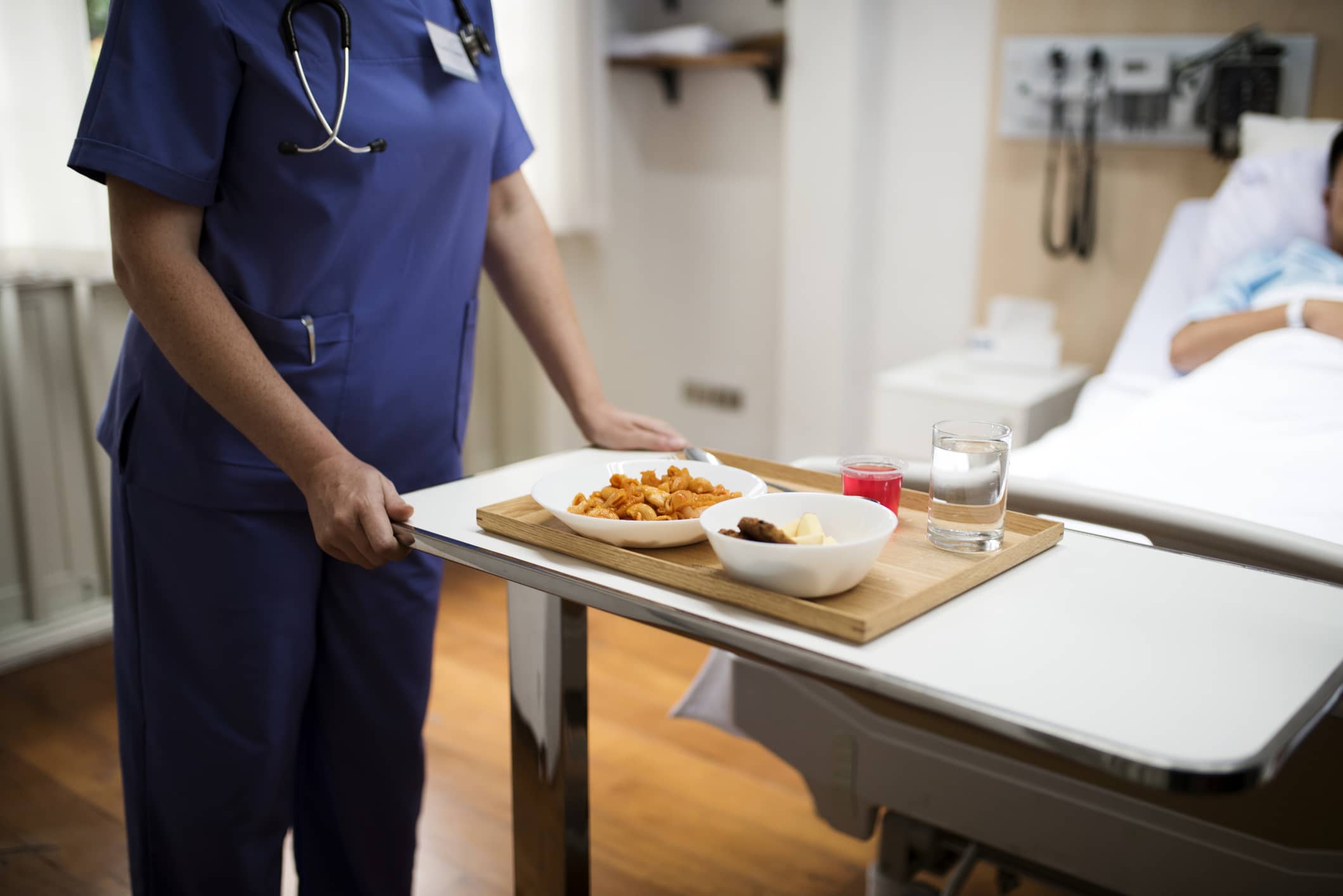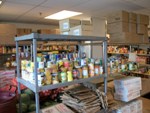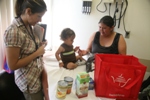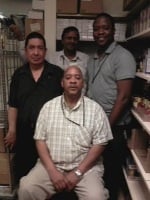
Hospital Food Pantries Offer a Prescription for Health
“Hunger is a national problem. Every city has this problem,” began Latchman Hiralall, DTR, food pantry manager at Boston Medical Center (BMC). “If a clinician is telling patients to eat healthy but they can’t afford it, the advice goes nowhere. Now our clinicians say, ‘You need to eat healthy and I can write you a referral to our food pharmacy.’ Clinicians are using our pantry to the max.”

When Boston Medical Center built the space for their food pantry, they also included a demonstration kitchen to provide cooking classes for patients.
When the BMC food pantry opened in 2001, it was supplying food to 500 to 600 families each month. They now serve more than 7,000, with 10,000 pounds of food per month being distributed. Clinicians write referrals for patients, indicating any dietary restrictions for the patient and their family members. The food bank workers then gather foods that take into account any dietary restrictions, and families can select foods from that group of items.
When the pantry started it was available only for children and pregnant women. Now anyone who comes to the hospital can get a referral to the food pantry.
“We haven’t specifically tracked how the pantry is improving patient outcomes, but we do survey recipients bi-annually and they communicate to us that the food is making a big difference in their lives,” commented Hiralall.
He says the two biggest challenges when starting a food pantry in a hospital are funding and space. The BMC pantry is funded entirely through philanthropy.
“You have to approach local businesses and retailers to see how much help they are willing and able to give. When you are talking about feeding hungry families, people really get on board,” Hiralall explained.
When the hospital constructed the space for the pantry it also included a demonstration kitchen.

A toddler tries a dried cherry from one of HCMC's food bags.
“We have a very diverse population so we sometimes have items that families are not familiar with; we hand out recipes and introduce new food items that way. Additionally, the dietitian regularly provides cooking demonstrations for different groups such as pregnant mothers, and people with hypertension, obesity, diabetes or cardiac issues,” he stated.
When considering starting a food bank, Hiralall advised finding a food source such as a major food bank, acquiring freezer and refrigeration space if perishables are to be offered, and finding transportation to pick up food from various sources. The BMC pantry shares refrigeration with the hospital’s nutrition services department.
When a patient picks up food from the BMC pantry, it is entered in their medical record so that their caregivers can know if they are using the resource.
“We also found that a number of patients had greater food needs, so we are helping them apply for the federal Supplemental Nutrition Assistance Program (SNAP),” he added. “The 17-page application can be very daunting, so there is someone here at the hospital two days a week to help. With this assistance, the number of people in our program receiving SNAP has increased from 20 percent to 35 percent.”
The Hennepin County Medical Center’s (HCMC) food pantry began after the Minneapolis-based institution conducted a research study on the effects of hunger in children less than four years of age. Convinced of the need to provide food for these young patients, an HCMC registered dietitian applied for, and won, a $5,000 grant to start a food shelf at the hospital.
“When a family comes to a pediatric clinic and the receptionist, or any employee, notices that the kids are fussy and seem hungry, the employee can offer them a bag of food,” explained Linda Carson, food shelf coordinator at HCMC. “The parent fills out a very basic form, confirming that they earn less than 200 percent of the poverty line income. When they receive their bag, which is made up in advance, we ask a few questions about their access to food and introduce them to the foods in the bag.”
“Each bag has what we call ‘comfort’ foods and ‘challenge’ foods,” she continued. “Comfort foods are foods the family is familiar with, challenge foods are new foods, but all of the items are chosen because they have a high nutritional value. Every bag that is going to a home with a child contains a tennis ball, which might be the only toy the child has ever owned.”
Some of the challenges the program faces are cultural. Many of HCMC’s patients from Peru and other South American countries were taught growing up that canned foods are unsafe.

The BMC food pantry staff selects foods from their pantry that are in line with a patient's nutritional needs and dietary restrictions.
“In the U.S., canned fruits and vegetables are an excellent option for providing families with inexpensive, nutrient-rich foods. Plus, canned foods are perfect for toddlers who don’t like their foods to be too hot, too cold or hard,” Carson said. “We hope that families might try a new food from our bag, discover they like it and then choose it for themselves when they are at the store.”
Every Sunday, 10 to 15 volunteers spend hours assembling food bags. During the month of May, HCMC provided 36,000 pounds of food to 1,235 families.
The bags are available in many of the hospital’s clinics including pediatrics, endocrine, rheumatology, HIV and cardiology. It is important to Carson that patients do not need a referral from a doctor to receive the food.
“It doesn’t require an advanced degree to see that someone is hungry. I’ve had a janitor bring someone to me who needed food,” she reflected.
“Those of our clinics that offer the food bags consistently have higher scores on our satisfaction surveys. Patients indicate that they feel like their providers care about them as a whole person, not just that their immunizations are up to date,” she said. “We had an immigrant from one of the Baltic States ask, “Is this how it is in America? You come to a doctor appointment and you get food!”
Each time another clinic wants to offer bags from the HCMC pantry, Carson insists that the program has the support of the head of the department and one medical assistant who will champion the program. That formula has been her key to success.
Carson sees offering a food shelf as nearly an essential for any county hospital.
“People are so pleased to get the food because it makes such a difference in their world,” she remarked. “It is hard for me to imagine offering medical care, and then sending the patient home hungry. It is a lot of work, but it is completely worth it and I would love to talk to anyone who would like more information.”


